

Rencontre avec le chef qui concocte les Pizzas Black Sabbath et les Danzig Burgers. Laura Lynn Jansen and Thomas Vailly "grow" stone tableware. Dutch designers Laura Lynn Jansen and Thomas Vailly have created a collection of tableware by "growing" stone over a structural skeleton using the same natural process that forms stalagmites and stalactites in caves (+ slideshow).
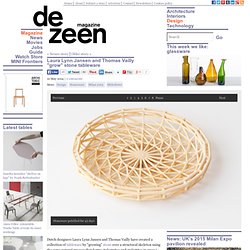
To create each piece in the collection, the designers placed a nylon 3D-printed skeleton into specially chosen thermo-mineral springs, where natural geological processes deposit calcium carbonate – also known as CaCO3, limestone or calc – onto the structure, reinforcing and thickening it to create a product with characteristics similar to terracotta or porcelain. Jansen and Vailly came up with the idea while visiting caves the Auvergne mountains in France as part of their research into natural processes they could incorporate into their work. "We got more and more amazed by the forms, textures and colours produced by nature," Vailly told Dezeen. BARB Perfume on Packaging Design Served. Musical rain. Biocouture. Suzanne Lee (art director), Liz Ciokajlo-Squire, Aaron Lampert,Thomas Makryniotis.

Design du vivant : salut ou ruine de l’humanité ? Faire pousser des vêtements, des chaussures, des maisons ?!
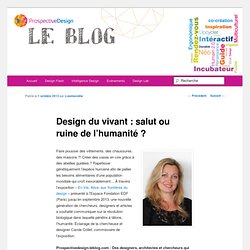
Créer des vases en cire grâce à des abeilles guidées ? Rapetisser génétiquement l’espèce humaine afin de pallier les besoins alimentaires d’une population mondiale qui croît inexorablement… À travers l’exposition « En Vie, Alive, aux frontières du design » présenté à l’Espace Fondation EDF (Paris) jusqu’en septembre 2013, une nouvelle génération de chercheurs, designers et artistes a souhaité communiquer sur la révolution biologique dans laquelle pénètre à tâtons, l’humanité. Synesthetic Sensory Stimulation with Ryoichi Kurokawa. Synesthetic Sensory Stimulation with Ryoichi Kurokawa.
BioElectric plastic made of chitin from crab shells by Jeongwon Ji. Royal College of Art graduate Jeongwon Ji has made her own bioplastic from crab shells.

Aiming to make a more tactile casing for electronic products, Jeongwon Ji extracted a derivatine of glucose called chitin from crustaceans and developed her own plastic from it by trial and error in the workshop. The resulting material, which she calls Crustic, combines the chitin with water and small amount of glycerin. "The Chinese mitten crab from Asia is one of the most invasive species and they are taking over the rivers in the UK," Jeongwon Ji told Dezeen. Cyborg artist Neil Harbisson uses his Eyeborg to listen to colour. Technology will increasingly be integrated into the body "to extend our abilities, our knowledge and our perceptions of reality", according to Neil Harbisson, the first officially recognised human cyborg (+ interview).
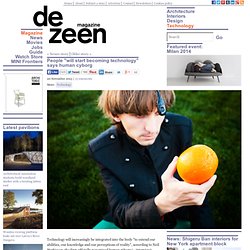
"We will stop using technology as a tool and we'll start using technology as part of the body," said Barcelona-based Harbisson, who wears a head-mounted antenna attached to a chip at the back of his skull that allows him to perceive colours. "I think this will be much more common in the next few years. " Harbisson wears the "eyeborg" headset to overcome a visual impairment called achromatopsia, which means he sees the world in shades of grey. The eyeborg turns colours into sounds, allowing him to "hear" them and meaning he qualifies as a cyborg, or cybernetic organism - a living being with both natural and artificial parts. BioElectric plastic made of chitin from crab shells by Jeongwon Ji. Light Painting The Electromagnetic Field. We're surrounded by things we can't see—and I'm not talking an invisible Kevin Bacon out to terrorise innocent people.
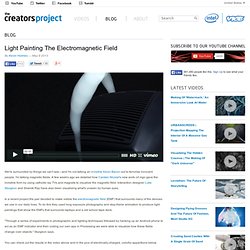
I'm talking magnetic fields. A few week's ago we detailed how Carsten Nicolai's new work crt mgn gave the invisible form by using cathode ray TVs and magnets to visualize the magnetic field. Interaction designer Luke Sturgeon and Shamik Ray have also been visualizing what's unseen by human eyes. In a recent project the pair decided to make visible the electromagnetic field (EMF) that surrounds many of the devices we use in our daily lives. To do this they used long exposure photography and stop-frame animation to produce light paintings that show the EMFs that surrounds laptops and a old school tape deck.
Eidos sensory perception enhancing masks at Royal College of Art. A group of students from the Royal College of Art in London has developed headsets that allow the wearer to adjust their sight and hearing in the same way they'd control the settings on a TV or radio (+ movie).
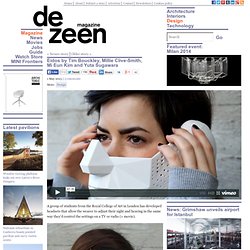
The Eidos equipment was developed to enhance sensory perception by tuning in to specific sounds or images amongst a barrage of sonic and visual information, then applying effects to enhance the important ones. "We've found that while we experience the world as many overlapping signals, we can use technology to first isolate and then amplify the one we want," say the designers. The first device is a mask that fits over the mouth and ears to let the wearer hear speech more selectively.
A directional microphone captures the audio, which is processed by software to neutralise background noise. 13 Appellations Wine design on Packaging Design Served. Interaction design portfolio. Narrative 2.0 visualises music.
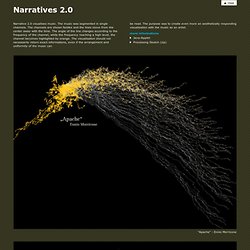
The music was segmented in single channels. The channels are shown fanlike and the lines move from the center away with the time. The angle of the line changes according to the frequency of the channel, while the frequency reaching a high level, the channel becomes highlighted by orange. The visualisation should not necessarily return exact informations, even if the arrangement and uniformity of the music can. Créateurs d'applications #1. Motstudio. Spaced Out - Le compositeur de l'espace. ECAL/LANTAL Fabric of Light. EXPERIMENTAL SHORT: "Primordial Radiance" on the The Creators Project Gallery. L'art génératif, qu'est-ce que c'est ? Décoder, décrypter et répondre aux questions de votre quotidien numérique : l’Antisèche est votre rendez-vous régulier sur RSLN.

Datavisualisation : peut-on tout dire en images ? Pour redonner du sens l’ère des données, il faut trouver de nouvelles façons de dire le réel.
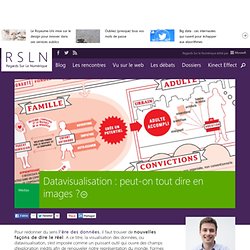
A ce titre, la visualisation des données, ou datavisualisation, s’est imposée comme un puissant outil qui ouvre des champs d’exploration inédits afin de renouveler notre représentation du monde. Formes et couleurs sont ainsi mobilisées pour expliquer de façon simple des chiffres, faits ou événements de plus en plus complexes. A tel point que David McCandless, le « pape de la datavisualisation », n’hésite pas à dire qu’une bonne image est celle qui « verse directement l’information dans nos yeux », presque sans avoir besoin de l’analyser.
En bref, une information liquide, limpide, sans aspérité. Mais peut-on rendre le monde simple comme une image ? SUBCONSCIOUS LIMBO TYPE. Billie Sue Chafins : « Remettre l'individu au coeur de l'expérience numérique » Lumière. 50 milliards d'objets connectés, et nous, et nous, et nous ?